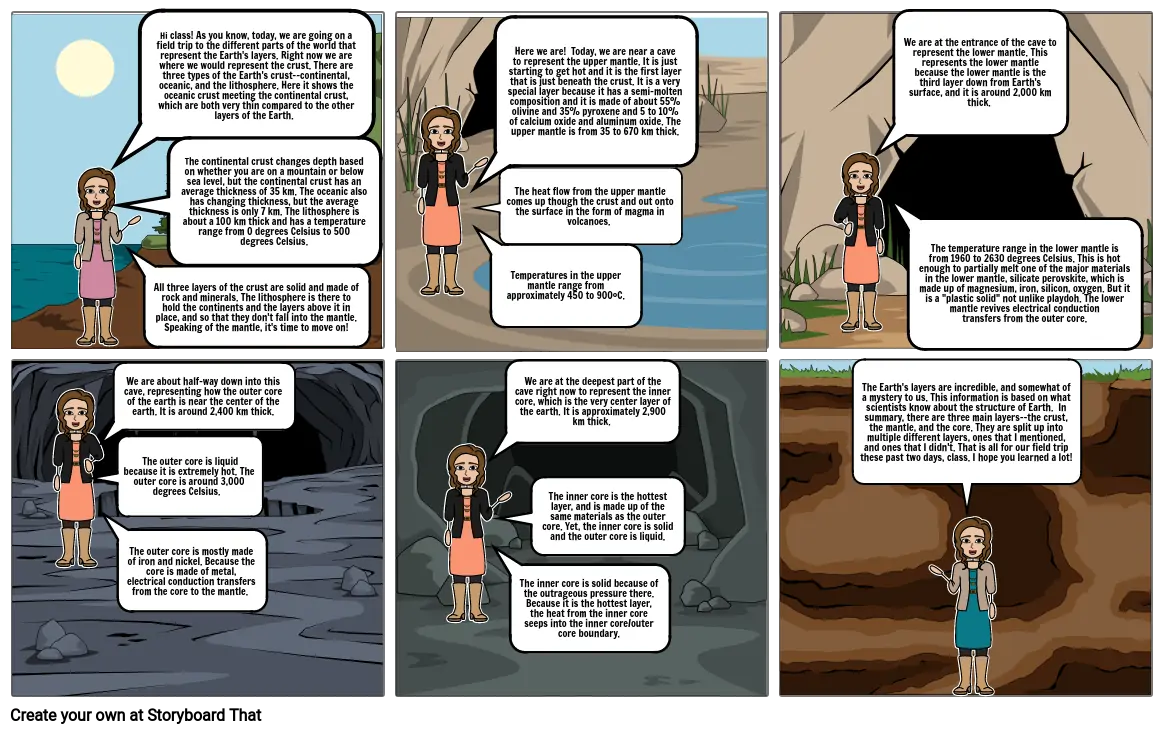Middle School students take a field trip around the world to learn about wh

Storyboard Description
A teacher taking her students around the world to explain what is going on underneath their feet.
Storyboard Text
- The continental crust changes depth based on whether you are on a mountain or below sea level, but the continental crust has an average thickness of 35 km. The oceanic also has changing thickness, but the average thickness is only 7 km. The lithosphere is about a 100 km thick and has a temperature range from 0 degrees Celsius to 500 degrees Celsius.
- Hi class! As you know, today, we are going on a field trip to the different parts of the world that represent the Earth's layers. Right now we are where we would represent the crust. There are three types of the Earth's crust--continental, oceanic, and the lithosphere. Here it shows the oceanic crust meeting the continental crust, which are both very thin compared to the other layers of the Earth.
- All three layers of the crust are solid and made of rock and minerals. The lithosphere is there to hold the continents and the layers above it in place, and so that they don't fall into the mantle. Speaking of the mantle, it's time to move on!
- Here we are! Today, we are near a cave to represent the upper mantle. It is just starting to get hot and it is the first layer that is just beneath the crust. It is a very special layer because it has a semi-molten composition and it is made of about 55% olivine and 35% pyroxene and 5 to 10% of calcium oxide and aluminum oxide. The upper mantle is from 35 to 670 km thick.
- The heat flow from the upper mantle comes up though the crust and out onto the surface in the form of magma in volcanoes.
- Temperatures in the upper mantle range from approximately 450 to 900°C.
- We are at the entrance of the cave to represent the lower mantle. This represents the lower mantle because the lower mantle is the third layer down from Earth's surface, and it is around 2,000 km thick.
- The temperature range in the lower mantle is from 1960 to 2630 degrees Celsius. This is hot enough to partially melt one of the major materials in the lower mantle, silicate perovskite, which is made up of magnesium, iron, silicon, oxygen. But it is a "plastic solid" not unlike playdoh. The lower mantle revives electrical conduction transfers from the outer core.
- The outer core is liquid because it is extremely hot. The outer core is around 3,000 degrees Celsius.
- We are about half-way down into this cave, representing how the outer core of the earth is near the center of the earth. It is around 2,400 km thick.
- The outer core is mostly made of iron and nickel. Because the core is made of metal, electrical conduction transfers from the core to the mantle.
- We are at the deepest part of the cave right now to represent the inner core, which is the very center layer of the earth. It is approximately 2,900 km thick.
- The inner core is solid because of the outrageous pressure there. Because it is the hottest layer, the heat from the inner core seeps into the inner core/outer core boundary.
- The inner core is the hottest layer, and is made up of the same materials as the outer core. Yet, the inner core is solid and the outer core is liquid.
- The Earth's layers are incredible, and somewhat of a mystery to us. This information is based on what scientists know about the structure of Earth. In summary, there are three main layers--the crust, the mantle, and the core. They are split up into multiple different layers, ones that I mentioned, and ones that I didn't. That is all for our field trip these past two days, class. I hope you learned a lot!
Over 30 Million Storyboards Created

